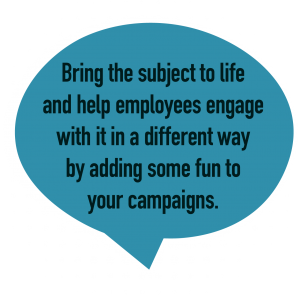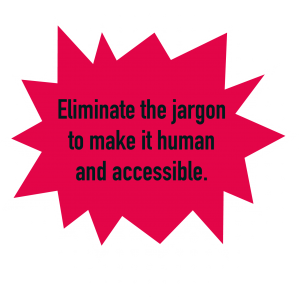Trying to engage people with a notoriously dry but incredibly important topic? Look no further…
Data compliance, security awareness, money laundering – there are certain topics that strike fear into the heart of even the most optimistic internal communicator. Here, Helen Deverell looks at how we can bring seemingly dull topics to life.
Explain why 
It sounds obvious but the ‘why’ is so often forgotten when communicating mandatory actions. Yes, people need to complete their money laundering e-learning module, but you might have to chase them less if they understand why it’s so important and how it might affect them personally.
For example, in a previous role I did anti-bribery training. I had reluctantly done it because I was told I had to and didn’t think it affected me at all. A few months later an agency that was pitching for some work with us started sending me gifts and offering me tickets to Wimbledon. Suddenly my training seemed very relevant.
If I’d had a relevant scenario like that shared with me before I would have approached the training completely differently.
What’s in it for me?
Relating dry topics to something more personal can encourage positive behaviours. For example, you’re communicating about how to keep confidential information secure. Why not also provide advice or guidance for employees to share with vulnerable elderly relatives who are often targeted by fraudsters wanting their personal information?
Or if you’re communicating how to keep premises secure through things like avoiding tailgating, always wearing your ID badge etc, you could organise a lunch ‘n learn for people to hear about how to use the latest technologies to help protect their own homes.
Make it fun 
I used to have the unenviable job of engaging employees with information security, but we found plenty of ways to add some fun to our campaigns.
One of the things we did was to run messy desk roadshows where we’d set up a desk full of the usual things you’d see on a busy employee’s desk. We then asked people to spot how many security breaches there were (i.e. post-it note with password on it, confidential papers left out in plain view, screen left unlocked). If they spotted them all they were entered into a competition to win an iPad. The purpose was to increase awareness on what constituted a security breach and we measured the success by tracking if the number of reported security breaches increased.
For another client we created a shooting stars style Halloween-themed quiz to communicate some coding principles to a specific team. It was an exceptionally dry topic, but it was imperative that the team not only knew what they were but understood why they were important. The quiz included multiple choice questions about the principles and of course there were Halloween costumes, games (including turning your colleagues into mummies using toilet roll) and a crow from below (as opposed to the dove from above).
It was elaborate, very silly and certainly wouldn’t work in every organisation, but it brought to life something important and helped employees to engage with it in a different way. When asked six months later those employees said they could still remember the coding principles and understood why they were important.
Use storytelling
As we all know, storytelling can be a powerful way of bringing information to life. There’s often a temptation with dry topics to share the consequences of taking the wrong action. However, you’re more likely to have an impact if you share stories of people doing the right thing. For example, how a potentially negative scenario was prevented through someone demonstrating the right behaviours.
In the past, I’ve also used animations to tell stories. We created a character who kept finding themselves in security scrapes with unfortunate consequences. It was always humorous and a bit tongue in cheek but got across an important message.
Stories help people understand the range of scenarios that might occur – things they might not have even considered as being problematic. And remember there are a range of ways to tell stories from blogs, articles, videos, face to face, animation, etc so spend time considering the best channel to bring it to life.
Choose your language carefully
So often the language around dull topics can be off-putting. For example, the word whistleblowing has connotations of being a snitch.
We need to eliminate the jargon and make it human. I recently heard about Rio Tinto, one of the world’s largest metals and mining corporations, and how they’d changed the name of their whistleblowing hotline to ‘’Talk to Peggy’. Peggy is a real person who heads up Ethics and Integrity. As a result, they saw calls to their hotline increase substantially. Just a simple name change, but it made it seem far more human and accessible.
Also review the wording in some of your policies – do they help people to do the right thing or do they just tell people what they must not do under any circumstances? When we write policies, we forget we’re writing them for human beings; our tone becomes formal, our sentences long and passive, the word ‘must’ creeps in everywhere and the final result is a five-page document that no one is ever going to read.
While the creation of policies is often out of our remit, there’s nothing stopping you working with other departments to help them shape them into something more palatable. After all, there’s little point in doing a fantastic, engaging campaign if the policies you’re directing people to completely jar with your tone and message.
Hopefully you’re now convinced that dull topics can be interesting, you just need to think a bit differently about them. We’d love to hear how you’ve brought dry topics to life in your organisations – share your experienced with us on Twitter!
By Helen Deverell for Alive!
















